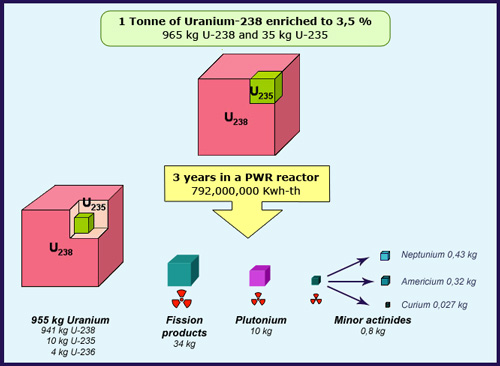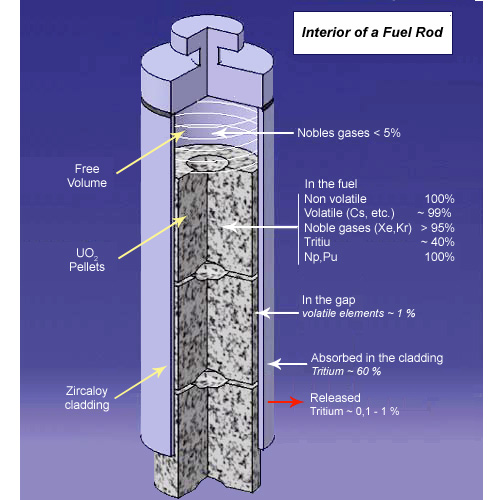Properties of spent reactor fuel
Highly radioactive spent fuel from nuclear reactors is a central focus for radioactive waste management strategies. The composition of such waste is a key factor in determining how it is managed.

Components of irradiated fuel
A tonne of fuel generally remains in a reactor for three years, during which time a very significant quantity of energy is released by irradiation. Whereas uranium 238 emerges from the reactor largely intact, 25 kg of the initial 35 kg of uranium-235 will have undergone fission. The fuel waste exiting the reactor will also include 34 kg of fission products, 10 kg of plutonium and 800g of actinides. All of the newly formed products are highly radioactive.
© IN2P3
The quantity of irradiated substances produced by reactors is relatively small in terms of their volume and mass. In France, the total represents approximately 1 kilogram per person per year, of which only a few grams are high-level waste, compared with 2.5 tonnes of industrial waste or 6.6 tonnes of carbon dioxide discharged directly into the atmosphere. In 2020, the accumulated volume of vitrified waste – which accounts for 98% of all radioactivity from waste in the national inventory – will be only 4,000 cubic metres, theoretically small enough to fit inside a cube measuring 16 m along each side.
Approximately 23 tonnes of spent fuel is removed from a pressurised water reactor each year, when one third of its fuel load is replaced. Across the French fleet of 58 reactors, some 1,200 tonnes of spent fuel is unloaded, of which 850 t will be reprocessed and 350 t placed in interim storage. Of these 350 tonnes, 135 tons are spent MOX.
A wide variety of radioactive products are formed as fuel is consumed in a reactor. In normal operating conditions, a spent fuel assembly consists of 94% uranium and around 1% plutonium, two materials with significant energy potential. The remaining 4 % consist of:– Fission products (approx. 4%) of which 0.3% long-lived elements and 0.2% intermediate-lived elements. – Minor actinides (approx. 0.1%): americium, curium, neptunium,– Activation products, formed as neutrons are trapped in structural materials such as support grids and the cladding hulls and end caps around the fuel pellets. Their contribution is relatively limited.

Radioelements in irradiated fuel
Spent fuel is an extremely complex system, due to the diverse nature of its constituent elements. Most radioactive atoms are trapped by the uranium oxide pellets inside the irradiated fuel rods. A few gaseous or mobile fission products (such as caesium, iodine, technetium or tritium) may be present in the gap between the pellets and the cladding. The role of the cladding is to prevent leaks.
© IN2P3
The uranium and plutonium still present in spent fuel possess impressive residual energy potential. When recalculated for a 500 kg assembly, the potential energy is equivalent to 10,000 tonnes of oil, based on the reactors in the current fleet. With fast breeder reactors, it would be equivalent to several hundred thousand tonnes of oil.
Fission products are highly unstable and therefore radioactive fragments of the split uranium nucleus. The time required to restore stability varies greatly. The final step – the transition to a stable nucleus – takes between one second and thousands of years. Certain fission products have not fully stabilised when the spent fuel is unloaded from the reactor. Fission product activity declines to near-insignificant levels within 300 years. A few residual long-lived fission products persist beyond the 300-year limit.
Plutonium and minor actinides result from failed fissions in which uranium nuclei have captured neutrons without splitting in two. These heavy nuclei are generally very long-lived. Such heavy nuclei are between 100 and 10,000 times more radiotoxic than fission products, but they are relatively immobile and the probability of them being ingested or inhaled is low.
One final major consideration from a waste management perspective is the heat released by radioactive disintegration. A vitrified waste package of approximately 150 litres initially releases 3,000 watts, tapering to 170 watts after 100 years and less than 30 after 300 years. Appropriate provision for removing this heat must be made.
Articles on the subject « Spent nuclear fuel »
Reactor unloading
Fuel unloading and initial pool storage of spent fuel The fuel load in a conventional pressurised[...]
Spent fuel Burn-up
Irradiation rate and energy supplied by fuel The energy produced by a nuclear power plant is prop[...]
Spent fuel composition
Key figures on spent fuel composition The composition of irradiated fuel removed from a reactor c[...]
Waste radioactivity decrease
A natural but slow decay process As natural radioactivity progressively decays, the radioactivity[...]
Spent fuel decay heat
Significant, slow-to-decline heat release The heat released by radioactive disintegration is a ke[...]
Spent fuel radiotoxicity
A risk indicator more pessimistic than radioactive activity Radioactivity is an imperfect descrip[...]